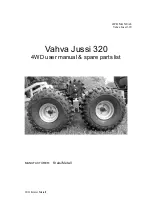
030-706-J0 Rev B
Page 21 of 26
7.2
Main Rectifier Modes
In addition to Main Rectifier States, there is a set of Main Rectifier Modes. These modes can be divided into two
categories as follows:
7.2.1
Output Voltage Modes
Voltage modes can be thought of as modes that, under software control, can directly adjust the output voltage.
The qualification of ‘under software control’ is made because there are processes that occur in the rectifier that
can change the output voltage that do not adjust the output voltage directly (such as the rectifier being in current
limit).
The following table lists the five Output Voltage Modes and a description of when they are active:
Output Voltage Modes
Active when…
Float
Output voltage is set to the float voltage setting.
Equalize
Output voltage is set to the equalize voltage setting.
Battery Test
Output voltage is set to the battery test voltage setting.
Safe
Output voltage is set to the safe mode voltage setting.
Manual Test
Output voltage can be manually adjusted outside of the standard adjustment ranges.
Table D–Output voltage modes
7.2.2
Output Current/Power Modes
These modes directly affect the output current and power.
The following table lists the four Output Current/Power Modes and a description of when they are active:
Output Current/Power Mode
Active when…
Temperature foldback mode
Output current and power limit have been reduced due to high temperature of the
heatsink or internal ambient temperature sensor.
AC foldback mode
Output current and power limit have been reduced due to low AC input voltage.
Note:
this will reduce the risk of tripping an AC breaker due to increased AC current draw as
the AC voltage decreases.
Short circuit foldback mode
Output current limit has been reduced due to a short circuit at the output.
Internal fault foldback mode
Output current limit has been reduced due to an internal fault.
Table E–Output current/power modes
7.3
Thermal Management
Heat dissipation of rectifiers is achieved through natural (bottom to top)
convection cooling. Performance of the rectifiers may vary depending on the
ambient temperature and whether the convection path of of the exhaust air
through the enclosure is hindered. A rectifier’s specified performance may also be
affected by adjacent rectifiers in the shelf.
Even with one or more Over-temperature and Current Limit alarms active, the
shelf is typically able to supply the demanded power steadily. For example, the
shelf can deliver 85% load at 40°C, with some alarms active. However, in higher
ambient temperatures, load reduction may be necessary.
Summary of Contents for 030-706-J0
Page 2: ......
Page 14: ......
Page 47: ...03070605B__ sch 1 Fri Mar 04 14 39 15 2005 ...
Page 48: ...03070605B__ sch 2 Fri Mar 04 14 39 49 2005 ...
Page 53: ...03070705B__ sch 1 Fri Mar 04 14 43 46 2005 ...
Page 54: ...03070705B__ sch 2 Fri Mar 04 14 44 27 2005 ...
Page 55: ...03070705B__ sch 3 Fri Mar 04 14 44 54 2005 ...
Page 61: ......
Page 62: ......
Page 63: ......
















































